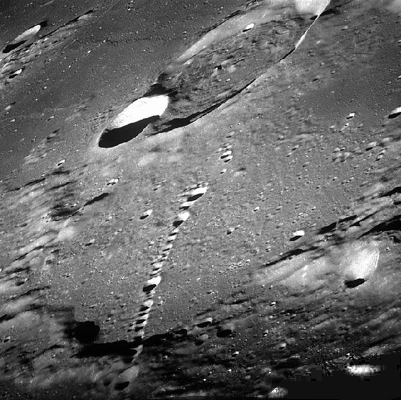Difference between revisions of "January 27, 2004"
| Line 37: | Line 37: | ||
[http://www.lpi.usra.edu/expmoon/Apollo16/A16metric1972.gif Apollo 16 view of Davy Chain]<br> | [http://www.lpi.usra.edu/expmoon/Apollo16/A16metric1972.gif Apollo 16 view of Davy Chain]<br> | ||
[http://www.boulder.swri.edu/~bottke/crater_chain/chain.html Crater Chains on the Earth & Moon]</p> | [http://www.boulder.swri.edu/~bottke/crater_chain/chain.html Crater Chains on the Earth & Moon]</p> | ||
| − | <p | + | <p><b>Yesterday's LPOD:</b> [[January 26, 2004|Hippalus Arcs]] </p> |
| + | <p><b>Tomorrow's LPOD:</b> [[January 28, 2004|Outrageous Lunar Colors]] </p> | ||
</table> | </table> | ||
<!-- start bottom --> | <!-- start bottom --> | ||
Revision as of 12:41, 1 February 2015
Davy's Chain
Image Credit: Apollo 12 (AS12-H-51-7485) |
|
Davy's Chain Is there any volcanism on the Moon? For the first half of the 20th century this had been a burning question. Finally, the 1949 publication of Baldwin's book convinced most scientists that lunar craters had formed by high speed impacts. But volcanism had also played a major role on the Moon for it produced the vast maria and the small domes. But was that all? The best example of another type of putative volcanic landform is the Davy crater chain, a 47 km long line of 23 craters that is superposed across the rectangular crater Davy Y. This alignment of one to three km wide pits is hard to see with scopes smaller than about 8", but spacecraft images provided a series of excellent views. (Davy is the 35 km wide crater at the top of the image with small central peaks and walls that have slumped onto its floor). The Davy chain is not a secondary crater chain because it isn't radial to any believable primary crater. Very high resolution images show that the craters probably formed at the same time because one crater's ejecta doesn't cover adjacent craters. So even today a few lunar scientists think that a line of simultaneously erupting volcanoes is the best interpretation. But there are no other volcanic features nearby. The most widely accepted explanation is that the Davy chain formed from the impact of the pieces of a tidally disrupted asteroid or comet that had been recently shredded by a too close approach to Earth. This is a Comet Shoemaker-Levy 9 phenomena applied to the Earth-Moon system. This ideal was independently proposed by Ewen Whitaker and Jay Melosh, and Bob Wichmann and Chuck Wood. Related Links: Yesterday's LPOD: Hippalus Arcs Tomorrow's LPOD: Outrageous Lunar Colors |
Author & Editor: |
COMMENTS?
Register, and click on the Discussion tab at the top of the page.
Contributions to http://www2.lpod.org/ are licensed under a Creative Commons Attribution No-Derivative-Works Non-Commercial 3.0 License. 




